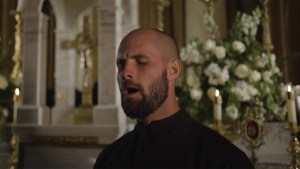Bishop Carl A. Kemme of the Diocese of Wichita, Kansas, released a pastoral letter on September 13 in which he urged a return to traditional liturgical sacred music in the Mass. Titled “On Sacred Music: Let Us Sing with the Lord,” the missive outlines many reasons why sacred music should be the preferred music of the liturgy, based on tradition, theology, and its ability to better engage the faithful in worship.
Before we dive into Bishop Kemme’s guidance, it is prudent to define sacred music. This is the traditional music of the church, which encompasses a wide selection of styles. While melody and instrumentation play a part in its distinction, sacred music is most clearly identifiable by its subject matter.
Sacred music exists solely for use within the Church and the Sacred Liturgy, it brings the focus on the Trinity and Scripture while eschewing the self. Mozart’s Requiem, Handel’s Messiah, and the catalogs of Catholic chant are examples of sacred music. Popular Christian songs like Hillsong United’s “Oceans” or Lauren Daigle’s “You Say,” however based in the Christian faith, are not considered sacred music.
Singing with the Lord
Bishop Kemme begins his instruction by reminding that the Mass is “an act of worship to the Father, through the Son, in the unity of the Holy Spirit,” in which Christ is offered as the perfect sacrifice for the sins of the world. He notes that this time of worship is meant to draw Catholics out of the world for a time, during which we learn to follow Christ’s example and offer ourselves as a living sacrifice in emulation of Christ.
Sacred music, the prelate said, helps to reveal this idea of self-gift. Bishop Kemme wrote:
“In the liturgy, we transcend space and time to participate in the sacrifice of Christ at the one altar that remains in the temple of the Heavenly Kingdom. From the onset, the music accompanying this procession should direct our thoughts to the particular mystery being celebrated, and it should resemble the song of the angels and the saints revealed to us in the scriptures.”
He noted that music that turns the focus towards the individual “can become self-serving rather than self-giving.” But rather than giving a list of songs which might fit this self-serving category, he directed the faithful to the “texts of the Mass, which the Church herself invites us to sing.” Just as the Church proposes texts for the Responsorial Psalm and Alleluia, so too does it provide proper texts intended to be sung at the Entrance, Offertory, and Communion processions.
There are thousands of such Mass settings written by hundreds of Catholic composers over the last 2,000 years, and many of them are set for specific services. Not only do they illuminate the particular mystery being celebrated each week, but they also prevent music ministers from experiencing the agony of weekly hymn selections. In addition, if every parish followed the music selections of the Roman Missal and Roman Gradual, Catholics the world over would be “singing the Mass” in unity as one voice.
Singing the Mass
Bishop Kemme noted that there is a difference between singing AT Mass and singing THE Mass. While he admitted it sounds like a minor distinction, it is an important part of participation in the Mass. Music is the language of prayer, supported by a famous quote attributed to St. Augustine: “He who sings prays twice.” There is a reason why the angels are always described as singing, and we are all called to sing the Mass in worship of the Lord.
The bishop explained that he believes that an understanding of sacred music can transform the way we approach liturgical music in the Mass. He wrote:
“When sacred music is closely associated with the liturgical action, it facilitates a more profound encounter with beauty, which is the second characteristic or principle of sacred music. In an audience with International Choirs, Pope Francis said, ‘Liturgical and sacred music can be a powerful instrument of evangelization because it gives people a glimpse of the beauty of heaven.’”
Secular music
On the topic of secular or popular Christian songs in Mass, Bishop Kemme cautioned against allowing them in the liturgy. This also extends towards the use of instruments in Mass other than the traditional tones of the organ and choir. He noted that the Mass is supposed to take Christians out of the world for a time so that they may return to it and consecrate the world to God.
To this end, it is important that the Mass contains music specific for worship that we would not hear in our daily lives. Just as the priest wears grander vestments for liturgical celebration than just the black shirt and collar, sacred music should be reserved for such special occasions as Sunday Mass.
“When liturgical music holds fast to these elements of our tradition, it expresses heaven’s true beauty because these particular traditions are primarily reserved for the liturgy. When an environment of beauty is cultivated, we encounter something other than ourselves, someone other than ourselves: we encounter God.”
Read Bishop Kemme’s full pastoral letter, “On Sacred Music: Let Us Sing with the Lord,” at the website of the Diocese of Wichita.



